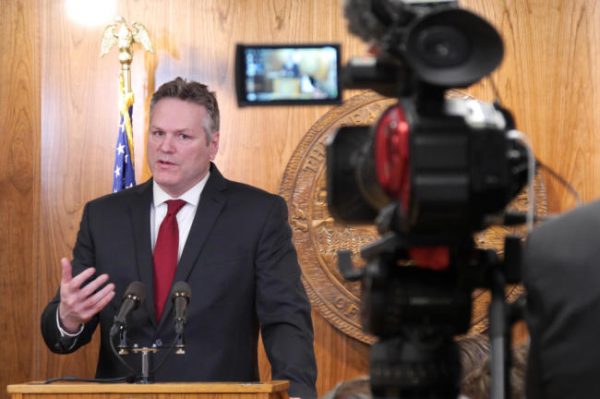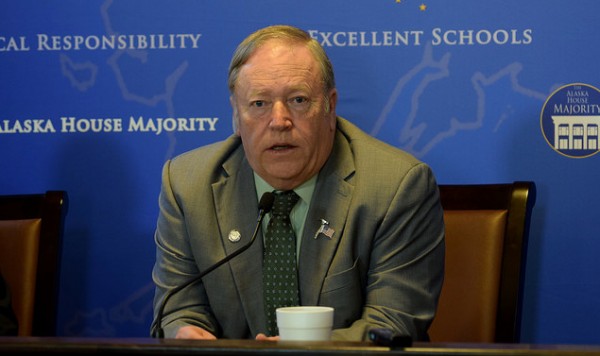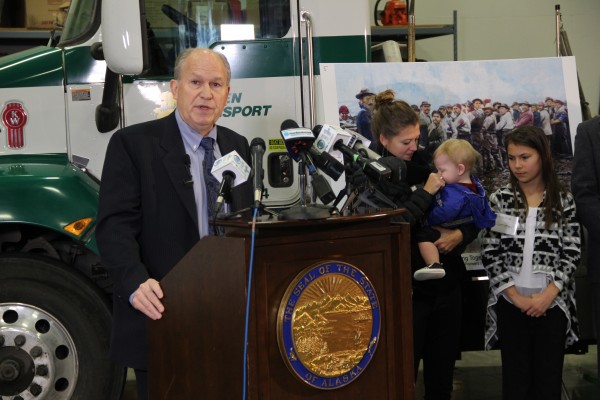
Last year’s budget proposal from Alaska Republican Gov. Mike Dunleavy was ambitious: record-sized Permanent Fund dividends of $2,900, a $300 million cut to schools and $400 million in oil taxes that would be diverted from municipalities to state accounts.
But by the time lawmakers finished debating the governor’s plan, none of those items remained: The Legislature sliced the PFD to $1,600, rejected the schools cut and dismissed the oil-tax diversion plan.
Veterans of the state’s drawn-out budget process say that those events are worth keeping in mind this week, as Dunleavy announces his proposed spending plan for next year. While the Alaska Constitution grants the governor substantial powers over state finances, they’re far from absolute, and the governor’s initial proposal often amounts to an opening offer instead of the last word.
After Dunleavy announces his preliminary plan, it’s transmitted to the state Legislature, which can accept the governor’s recommendations, water them down or reject them outright — which is what happened with several of Dunleavy’s ideas last year, like many governors before him.

“I’ve been there when they actually took the governor’s budget when they handed it out and just threw it in the garbage,” said Mike Chenault, the retired legislator who spent eight years as House speaker.
A spokesman for Dunleavy, Jeff Turner, said that the governor was not available for an interview.
Dunleavy is set to release his new budget proposal Wednesday in Juneau. The state still faces a substantial deficit, though the governor has ruled out resurrecting some of the failed elements of his proposal for the previous year, his first in office.
Dunleavy said that his initial proposal, released in February, would have balanced the state budget through deep cuts to spending on schools, health care, ferries and Alaska’s university system.
[Read more: Sweeping budget lowers spending on schools, university, Medicaid, ferries]
His budget plan was undergirded by roughly a dozen bills needed to carry out his spending plans or make them permanent — by repealing certain programs, appropriating cash for dividends or eliminating certain municipal taxing authorities, for example.
But none of those bills made it through the Legislature. And lawmakers scaled back or dismissed many of Dunleavy’s proposed reductions in the budget bill itself.
[Read more: Alaska House subcommittees propose much smaller cuts than those in Dunleavy’s budget]
“No one has a slam dunk on this,” said Anchorage Republican Rep. Jennifer Johnston, co-chair of the House Finance Committee. “The governor’s budget is the start. It’s not the finish.”
A similar process transpired in 2016 under Dunleavy’s predecessor, independent Bill Walker. Walker proposed to close the state’s multi-billion-dollar deficit by restructuring the Permanent Fund and reducing dividends, along with raising revenue through an array of taxes — including on personal income, on gasoline and on the mining and fishing industries.

Each of those ideas, however, required its own piece of legislation. And lawmakers rejected nearly all of them, agreeing only to a modified version of Walker’s oil tax proposal.
The framers of Alaska’s constitution envisioned such an interplay between the executive and legislative branches, according to Gerald McBeath, a retired University of Alaska Fairbanks political science professor.
The framers had been frustrated by Alaska’s weak territorial executives and wanted to give the governor expansive powers, McBeath said.
“But they also wanted a strong legislature. And it was refreshed more frequently than the governor, and for that reason was closer to the people,” McBeath said. “And so the Legislature is the major check.”
One other complication for Dunleavy is that Medicaid spending, one of the budget’s biggest line items, is guided by state and federal law. Which means that even though he and lawmakers cut the Medicaid budget this year, Alaskans were still entitled to largely the same services that they were previously — leaving the state with higher costs than planned.
But the governor does have one final trump card: line-item veto power, which can only be overturned by a three-fourths majority vote by the Legislature — the highest hurdle of all 50 states.
[Read more: Alaska Gov. Dunleavy’s red veto pen looms over this year’s budget debate]
After lawmakers boosted the spending levels initially proposed by Dunleavy earlier this year, the governor line item vetoed hundreds of millions of dollars from the budget. The Legislature again added money back during a subsequent special session, but Dunleavy vetoed much of that spending, too.
One dynamic likely to decide the success of Dunleavy’s upcoming budget proposal is his relationship with the Legislature, according to Chenault, the former House speaker. It’s much easier for a governor to impose their vision when they have a good working rapport with state lawmakers — and that didn’t exist last year, Chenault said.
Since then, though, Dunleavy has replaced some of his top advisors who lacked close relationships with legislative leaders, including former budget director Donna Arduin and chief of staff Tuckerman Babcock.
“The Legislature has a lot of power. They’ve got the power of the purse,” Chenault said. “While we have one of the most powerful governors in the U.S., you still have to be able to work with those legislators in order to get anything passed.”
Nathaniel Herz is an Anchorage-based journalist. He's been a reporter in Alaska for a decade, and is currently reporting for Alaska Public Media. Find more of his work by subscribing to his newsletter, Northern Journal, at natherz.substack.com. Reach him at natherz@gmail.com.




